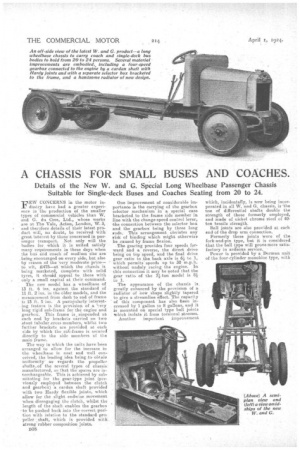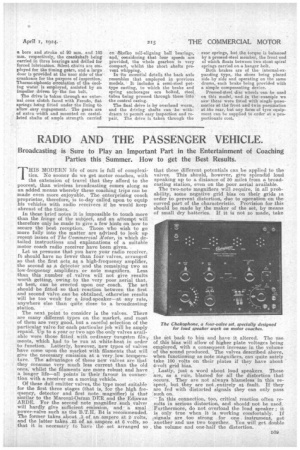A CHASSIS FOR SMALL BUSES AND COACHES.
Page 32

Page 33

If you've noticed an error in this article please click here to report it so we can fix it.
Details of the New W. and G. Special Long Wheelbase Passenger Chassis Suitable for Single-deck Buses and Coaches Seating from 20 to 24.
FEwCONCERNS in the motor industry have had a greater experience in the production of the smaller types of conimercial vehicles than W. and G. du Oros' Ltd., whose works are at The Yale, Acton, London, W. 3, and therafare details of their latest preduct will, no doubt, be received with great interest by those concerned in passenger transport. Not only will the bodies for which it is suited satisfy many requirements in these days when the bus and 'coach of mediuni si.e are . being encouraged on every side, but also by reason of the 'very moderate price-to wit, .2475—at which the chassis is being marketed, complete -with solid tyres, it should appeal to those with only a small capital at their command.
The new model has a wheelbase of 13 ft. 6 ins, against the standard of 11 ft. 2 ins, in the older models, and the measurement from dash to end of frame is 13 ft. 5 ins. A partifiularly -interesting feature. is the provision of a ...:ery long rigid sub-frame for the engine and gearbox. This frame is suspended at each end by brackets carried on two stout tubular cross members, whilst two further brackets are provided at each side by which the sub-frame is secured directly to the side members of the main frame.
The way in which the units have been arranged to allow for the increase in the wheelbase is neat and well conceived, the leading idea being to obtain uniformity as regards the propeller. shafts.,of the several types of chassis. manufactured, so that the spares are interchangeable. This is achieved by substituting for the gear-tYpe joint (pre• viausly employed between the clutch and gearbox) a card-an shaft provided with two Hardy flexible joints, -which allow for the slight endwise movement when disengaging the clutch, whilst the length of the shaft enables the gearbox • -to be pushed back into the-correct .position -v6th• relation to the standard pro, pellei--..shaft; which is provided with
strong rubber composition joints. . D38 One improvement of considerable importance is the carrying of the gearbox selector mechanism. in a special case bracketed to the frame side member in line with the change-speed control lever, the connection between. the selector box and the gearbox being by three long rods. This arrangement obviates any risk of binding which might otherwisa be caused by frame flexion.
The gearing provides four speeds forward and a reverse, the direct drive being on top speed, and the final drive gear ratio in the back axle is 4 to 1, which permits' speeds up to 30 m.p.h. -without unduly racing the engine. In this connection it may be noted that the gear ratio of the 4-ton. model is 4 to 1.
The appearance of the chassis is. greatly enhanced by the provision of a radiittor of new shape slightly tapered to give a streamline effect. The capacity of this component has also been increased by 1 gallon to 8 gallons, and it is mounted on special type ball joints which isolate it from torsional stresses.
Another important improvement
which, incidentally, is now being incorporated in all W. and G. chassis, is -the use of differential shafts double the strength of those formerly employed, and made of nickel chrome steel of 40ton tensile strength.
Ball joints are also provided at. each end of the drop arm connection.
Formerly these joints Were of the fork 'and-pin type, but it is considered that the ball type will prove more satisfactory in arduous service. Power is provided by a Dorman unit of the four-cylinder monobloe type, with
a bore and stroke of 90 mm. and 140 min, respectively, the crankshaftbeing carried in three bearings and drilled for forced lubrication. Silent chains are employed for the timing gears, and a large door is provided at the near side of the crankcase for the purpose of inspection. Thermo-siphonio circulation of the cooling water is employed, assisted by an impeller driven by the fan belt.
The drive is taken through en external cone clutch faced with Ferodo, flat springs being fitted under the lining to allow, easy engagement. The gears are of extra width and mounted an castellated shafts of ample strength carried on iSkefko self-aligning ball bearings, and, considering that four speeds are provided, the whole gearbox is very compact, whilst the short shafts prevent whipping. In its essential details the back axle resembles that employed in previous models. It. includes a semi-steel pottype casting, to. which the brake and spring anchorages are bolted, steel tubes being pressed through these into • the central casing.
The final drive is by overhead worm, and the driving shafts can be withdrawn to permit easy inspection and repair. The drive is taken through the
wear springs but the torque is balanced by a pressed-steel member, the front end of which floats between two stout spiral springs carried on a hanger bolt.
Bath brakes are of the internal-expanding type, the shoes being placed side by side and operating on the same drums, each brake being provided with a simple compensating device. , • Pressed-steel disc wheels can -be used on this model, and in the .emainple we saw these were fitted with single pneumatics at the front and twin pneumatics at the rear, but any form Of tyre equipment can be supplied to order at a proportionate cost.






















































